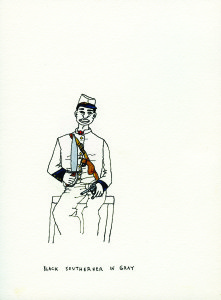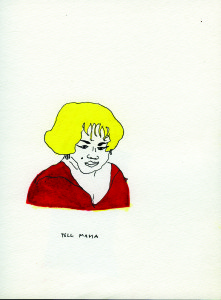In Come home Charley Patton (Wesleyan University Press, 2013), choreographer, writer and visual artist Ralph Lemon journeys through personal and Civil Rights history like a migrant worker. Gleaning ancestral fruits—both rotted and revelatory—in this 240-page volume chronicling the final chapter in a trilogy including Geography (2000) and Tree (2004), Lemon’s re-creation research unfolds restlessly, graphically, honestly. It is a nine-year odyssey originating on the contours of the 1961 Freedom Bus Ride, riding rail through living rooms, motels and lynching sites in the Deep South and the North, and finding home in the same “bottomless soul” Lemon has always gravitated to—a place of music, a dance.

Reading the book with limited awareness of America’s cultural, racial and social history doesn’t preclude drawing rich, complex understanding from Lemon’s stories about well-knowns like writer James Baldwin, activist Medgar Evers, or musician Charley Patton, in whom the earliest Delta Blues found their genesis. And Lemon’s family history—exposed in the raw language of confession or tinged, soft-edged by the nostalgic fog of memory or third-person accounts—speaks to the journeyman in all of us. We, the readers, are no different than Lemon and his frequent companion, daughter Chelsea, who documents the trip and ensures meals are had. We, too, stagger under the constant shift of society’s collective center. We search for truth, then fight its discovery.
But we don’t all write books, draw or paint naive/profound images and make dances. Lemon does. Addressed separately in review, the artistic tripod of word, image and dance composes the structure underlying not just Charley Patton’s balance, but Lemon’s body of work.
Lemon was born and grew up in Minneapolis, Minnesota, where his father boasted, “We made the city black.” His parents and 31 other African American families migrated courtesy of job transfers to the city whose entire population when they arrived in 1963 was barely two percent black. His size, relative to the local bullies he recalls, and gentle nature, had as much to do with the blows and bifurcation he experienced, as did his race. Dance took him from the midwest to New York City in the late 1970s, where he worked with Meredith Monk before forming his own company in 1985. Heralded for formal, proscenium-suited dances whose classicism and romanticism pulsed, swelled and occasionally exploded into aggressive, cathartic release. Lemon has said he found himself making the same spectacular dance, over and over again. He folded the company in 1995 and hit the road. Since then, he has engaged in extended, sometimes decade-long excavations to unearth the relevance of collective and individual bodies. The term, bodies, spread multi-directionally, speaks to race, class, gender, geography, ethnicity, history, spirituality and instinct.
Charley Patton, similarly, packs a full gamut of literary possibilities. From the minutia of an email or an overheard street conversation to introspective slogging through the mental aspects of creating “biological physical theater” to medley-like lists of civil rights/choreographic/family landmarks in “incomplete chronologies” to Baldwinian paraphrases to intimate reflections composed with vulnerable craft, Lemon demonstrates solid writing chops. In downtown Birmingham, he hears a musician “who plays like really good white musicians play the blues, deceptively and with the same excited, technically brilliant aggression with which they rule the world.” He adds:

“Although Jimi Hendrix also played the blues that way.” And later, railing against “desk art” and “Living Room Dance” (although, in the making of Charley Patton, he dances in a number of living rooms), Lemon considers art “beyond the mire of a soul’s unfiltered messiness. Sometimes, at its best,” he writes, “it sits in shit, nonfiction. And poor. Also possibly fake.” Agile writing marries truth and defiance and as a result, descriptions gain gravity.
If words are the spine-like column upon which Lemon hangs his serpentine skeleton of blues music, artistic hubris, lynchings, fire hoses, lost trumpets, racism’s vile imprint, lingering love and the whittling impact of age on a human body, then images are the book’s life-sustaining organs. A drawing of a not-so-ready baseball batter is tender, delicately rendered. A Miles Davis portrait is barely there, but vital in its blackness. A photo of the Blue Front Cafe suggests hoped-for immortality and a series of “Dramatic Games” drawings manage to be both sinister and life-affirming. Photographs by The New York Times’ Andrea Mohin catapult a reader into the present, reminding us of the book’s—and Lemon’s—origins in movement.
Dance then, is the breath and blood of the constructed form. Oddly, the book falters, losing momentum when Lemon returns to the studio and begins to focus on making the dance that will become the third performance piece in the Geography trilogy. Bruce Nauman’s Wall-Floor Positions may have “floored” Lemon, but writing about them stalls the narrative. A subsequent staircase of injured dancer communications and self-questioning about the veracity of “African American” as a calling card result in similar stasis. Thankfully, the energy gears up—largely due to the visuals—as Lemon steps forward, into his dancer’s body and accompanied by edited texts from Baldwin. A 150-year migration, from the Emancipation Proclamation in 1863 to Ralph Lemon in 2013 leaves a reader with only one question: Where shall we go next?
This article appeared in the December 2013 issue of In Dance.

